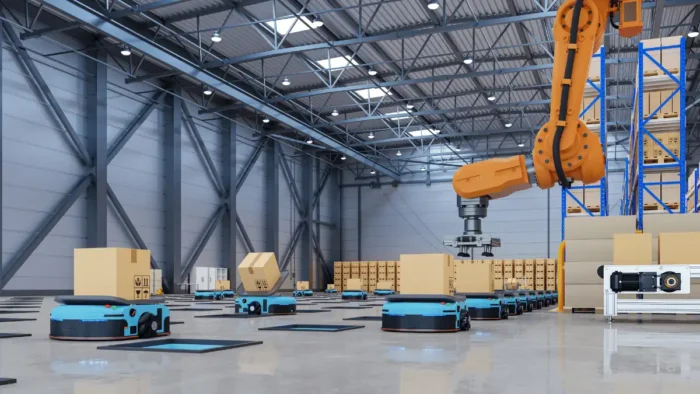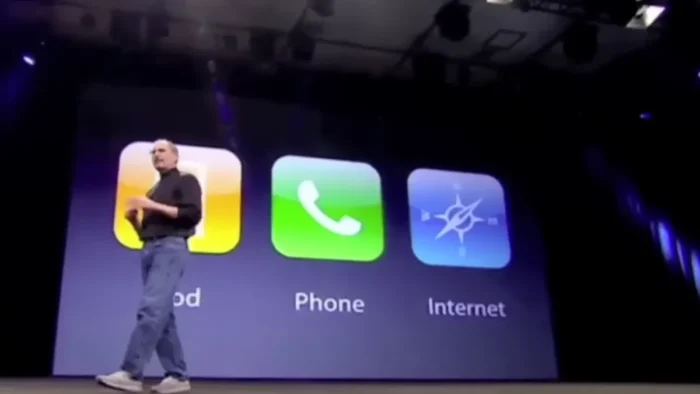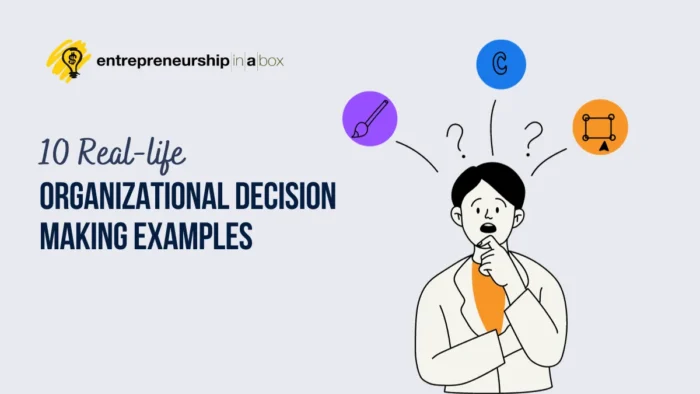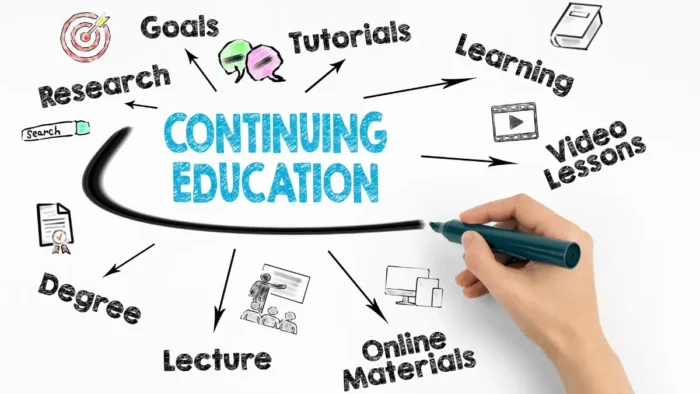Imagine the power of making the right decision at the right time for your organization. Now imagine making those decisions consistently across various industries, from fast food to technology and crisis management. Organizational decision-making examples are the key to unlocking growth and innovation.
In this blog post, we will explore 16 real-life instances of organizational decision-making that have shaped industries and redefined markets.
📖 Key takeaways
- Organizational decision-making is essential for success in the fast food industry, requiring careful consideration of various factors.
- Companies must make strategic decisions about workforce management to maximize employee satisfaction and productivity.
- Product development decisions can have a major impact on their respective industries, such as Apple’s launch of the iPhone and Tesla’s strategy for electric vehicles.
Organizational Decision-Making in the Fast Food Industry

An effective marketing strategy and rational decision-making are key in the competitive fast-food industry, where customer tastes change quickly. Identifying and selecting the optimal course of action to reach organizational objectives requires carefully considering various factors within the creative decision-making process. In this context, the decision-making process involves analyzing aspects such as cost, benefits, customer preferences, market trends, and competition and making tactical decisions.
This is especially important in stressful situations, where quick and informed decisions can significantly impact the success of a fast food business, highlighting the importance of a decision-maker and the key takeaway decision-making, as well as the consequences of a poor decision-making process.
We’ll highlight the importance of the decision-making process in this sector with good business decisions examples: McDonald’s move towards a healthier menu and KFC’s addition of plant-based options.
McDonald’s Healthy Menu Shift
Health considerations have become increasingly relevant in recent years, with a growing awareness of the correlation between fast food and illnesses such as heart disease, diabetes, and obesity. Recognizing the need to adapt, McDonald’s decision-makers introduced healthier menu options in 2013. The company added more fruits and vegetables, promoted nutritional options for children, and committed to using antibiotic-free chicken, among other modifications.
This transition to healthier menu options had a beneficial effect on McDonald’s sales and customer perception. By addressing health concerns and consumer demands, McDonald’s saw an increase in sales, improved profitability, and attracted new customers who were searching for healthier food options.
KFC’s Expansion into Plant-Based Options
In a comparative manner, KFC identified the rising demand for vegan and plant-based meals and accordingly adjusted its menu. They introduced various plant-based options, such as the KFC Vegan Burger and Vegan Nuggets, following a decision-making model that considered the evolving market trends.
Although KFC’s addition of plant-based options had mixed effects on their sales and revenue, the increasing demand for plant-based alternatives and the success of plant-based food sales in general indicate potential for growth in this market. The company’s decision to offer plant-based options positioned KFC as an innovative and forward-thinking brand in the fast-food industry, providing valuable lessons for other businesses.
Related: The Team Effectiveness and Different Roles in Teams That Win
Technology Implementation Decisions

Decisions about technology implementation, including programmed decisions, can considerably affect a company’s efficiency and client satisfaction. Organizations can improve their operations and offer improved services by searching for the best available technologies and solutions.
Amazon’s use of robotics in warehouses and Starbucks’ mobile ordering system are two prime instances of successful technology applications that their decision-makers made.
Amazon’s Use of Robotics in Warehouses
Amazon’s decision to employ robotics in its warehouses was driven by the desire to enhance efficiency and minimize costs. The company employs a variety of robots, including mobile robots and AI-powered systems, to manage millions of diverse products and improve the productivity of its workforce.
Implementing robotics at Amazon’s warehouses has led to notable improvements in efficiency. Productivity and speed have both increased, enabling Amazon to process and ship orders more quickly and accurately. This strategic decision has improved the company’s operations and given it a competitive edge in the market.
Starbucks’ Mobile Ordering System
Starbucks recognized the need for greater customer convenience and decided to implement a mobile ordering system. This system allows customers to:
- Place orders directly from their phones
- Pay for their orders through the app
- Choose a pickup location and time
- Skip the line and pick up their order without waiting
This mobile ordering system reduces wait times and improves the overall customer experience.
The mobile ordering system has significantly improved Starbucks’ operational efficiency and customer satisfaction. Additionally, the mobile app utilizes machine learning to provide personalized recommendations, which can increase sales and foster customer loyalty. Although the company faced some challenges during the implementation process, its creative decision-making led to the successful development and adoption of the mobile ordering system.
Crisis Management Decisions

Crisis management decisions can make or break a company’s reputation. During a crisis, organizations must take swift and effective action to manage the situation and limit harm.
Two such examples are Toyota’s response to the 2009 acceleration recall and BP’s handling of the Deepwater Horizon oil spill.
Toyota’s Response to the 2009 Acceleration Recall
In 2009, Toyota faced a major crisis when it was discovered that some of their vehicles had accelerator pedals that could become stuck, causing unintended acceleration. The company recalled millions of vehicles worldwide and addressed the risk of floor mats trapping the accelerator pedal.
Although the recall hurt Toyota’s reputation, the company’s swift action and transparency in addressing the issue ultimately helped recover its reputation over time. This example of rational decision-making demonstrates the importance of effective crisis management in preserving a company’s image and maintaining customer trust.
BP’s Handling of the Deepwater Horizon Oil Spill
In contrast, BP’s handling of the Deepwater Horizon oil spill in 2010 faced significant criticism. The company’s response was seen as inadequate, and its efforts to contain the spill and remediate the environmental damage were met with skepticism.
The consequences of BP’s handling of the oil spill were far-reaching, with substantial environmental and social impacts, as well as long-term effects on the company’s reputation. This example highlights the need for creative decision-making and effective crisis management to minimize damage and maintain public trust.
Organizational Restructuring Decisions
Organizational restructuring or high-level managerial decision-making can significantly change a company’s focus and direction. Organizations can adapt to changing market conditions and seize new opportunities by making calculated strategic decisions through group decision-making.
We will review two instances of organizational restructuring decisions in this part, as discussed in the Harvard Business Review: IBM’s transition from hardware to services and General Electric’s portfolio adjustment.
IBM’s Shift from Hardware to Services
In response to changing market demands and heightened competition, IBM decided to shift its focus from hardware to services, such as cloud computing and artificial intelligence. This transition resulted in a shift in revenue streams, a business model transformation, and a product line expansion.
By adapting to evolving market trends and leveraging its expertise in technology and services, IBM has successfully repositioned itself as a leading provider of IT services, demonstrating the power of strategic restructuring decisions.
General Electric’s Portfolio Realignment
Similarly, General Electric (GE) recognized the need to realign its portfolio to better focus on key industries and divest non-core assets. The company’s strategic restructuring involved concentrating on Aviation, Power, and Renewable Energy as core businesses, with Healthcare becoming a separate company.
This realignment allowed GE to optimize operational performance, facilitate growth, and maximize shareholder value. The example of GE’s portfolio realignment showcases how organizational restructuring decisions can create new opportunities and drive success.
Mergers and Acquisitions Decisions

Decisions related to mergers and acquisitions play a pivotal role in a company’s expansion and market standing. Organizations can access new markets, technologies, and resources by acquiring or merging with other companies.
In this part, we will study two standout examples of mergers and acquisitions decisions: Disney’s takeover of Pixar and Microsoft’s acquisition of LinkedIn.
Disney’s Acquisition of Pixar
Disney’s acquisition of Pixar was a strategic move that aimed to:
- Strengthen its animation capabilities and market presence
- Gain access to cutting-edge animation technology and creative resources
- Broaden its reach in the animation industry
- Produce top-notch computer-animated feature films.
The acquisition has had a significant impact on Disney’s market strength and competitiveness, as well as its animation capabilities. This example highlights the potential benefits of mergers and acquisitions decisions in driving growth and innovation.
Microsoft’s Purchase of LinkedIn
Microsoft’s decision to acquire LinkedIn was driven by the desire to:
- Expand its professional networking and social media reach
- Integrate LinkedIn’s user profile data with its Office products
- Expand its offerings and enter new markets.
The purchase of LinkedIn has significantly impacted Microsoft’s growth and market position, demonstrating the potential benefits of mergers and acquisition decisions for companies looking to expand their reach and access new resources.
Corporate Social Responsibility Decisions
Decisions related to corporate social responsibility (CSR) can boost a company’s standing and dedication to sustainability. By course of action in responsible business practices and supporting environmental and social causes, companies can demonstrate their accountability and attract customers who value ethical business practices.
In this part, we will examine the CSR initiatives of two firms: Nike’s pledge to sustainability and Patagonia’s eco-activism.
Nike’s Commitment to Sustainability
Nike’s commitment to sustainability is evidenced by its numerous initiatives to reduce environmental impact and enhance working conditions in its supply chain. The company has set specific sustainability goals like:
- Transitioning to 100% renewable energy in its operations
- Reducing carbon emissions
- Minimizing waste and increasing recycling
- Improving water management practices
- Ensuring fair labor practices throughout its supply chain
These initiatives demonstrate Nike’s dedication to creating a more sustainable and responsible business model.
By implementing these sustainability initiatives, Nike has demonstrated its commitment to environmental and social responsibility and maintained its reputation as a responsible and socially conscious brand.
Patagonia’s Environmental Activism
Patagonia’s dedication to environmental activism is deeply ingrained in its business operations and culture. The company supports various environmental causes, such as providing grants to organizations that address the root causes of environmental issues, reducing carbon emissions, and advocating for system changes.
Patagonia’s commitment to environmental activism and sustainable business practices has positively impacted its reputation and showcased the importance of CSR decisions in aligning a company’s values with its actions.
Workforce Management Decisions

Decision-making about workforce management can considerably influence worker satisfaction and productivity. Organizations can ensure that their employees are satisfied and productive by making strategic choices regarding hiring, training, and workplace policies. Managerial decision-making plays a crucial role in achieving these outcomes.
We will look into two examples of workforce management decision-making in this part: Google’s unique hiring strategies and Twitter’s (now X) policy on remote work.
Google’s Innovative Recruitment Strategies
Google is renowned for its unique recruitment strategies, which focus on optimizing the hiring process and identifying high-caliber employees through national or international search. The company’s approach to recruitment, which includes proactive outreach, targeted job ads, and a focus on employee support, has resulted in a highly talented and competent workforce.
These innovative recruitment strategies have contributed to the company’s success and innovation and demonstrated the importance of effective workforce management decisions in attracting and retaining top talent.
Twitter’s Remote Work Policy
In response to the COVID-19 pandemic, Twitter implemented a remote work policy, which allowed employees to work remotely or come into the office based on their preference. This policy (canceled after Elon Musk’s acquisition of Twitter) prioritized employee safety and well-being while maintaining productivity and business continuity.
Although Twitter encountered some challenges in implementing its remote work policy, such as maintaining effective communication and collaboration among remote teams, the overall impact on employee productivity and satisfaction was positive.
Product Development Decisions
Decisions on product development can lead to industry changes and open up fresh market opportunities. By investing in innovation and taking calculated risks, companies can disrupt existing markets and redefine customer expectations.
We will discuss two examples of game-changing product development decisions in this part: Apple’s launch of the iPhone and Tesla’s strategy for electric vehicles.
Apple’s Introduction of the iPhone

Apple’s decision to develop and launch the iPhone transformed the smartphone industry by introducing features such as a touchscreen interface, the App Store, and internet accessibility. The iPhone redefined the smartphone category and set the standard for modern devices, demonstrating the power of product development decisions in driving growth and innovation.
The introduction of the iPhone has substantially impacted Apple’s financial performance, with the device becoming one of the company’s most successful products and accounting for almost 50% of its total revenue.
Tesla’s Electric Vehicle Strategy
Tesla’s electric vehicle strategy has disrupted the automotive industry and accelerated the adoption of electric cars. The company’s unique approach to vehicle production, which focuses on innovation and design thinking, has enabled it to successfully implement its electric vehicle strategy and compete against established automakers.
The impact of Tesla’s electric vehicle strategy on the automotive industry is significant, as it has provoked other automakers to invest more in electric vehicle technology and helped increase the adoption of electric vehicles in the industry.
Why is Decisiveness at Work Important?
Decisiveness is your capability to make the right decisions with confidence and quickly. It’s a crucial characteristic for successful managers, allowing them and their team members to move forward. Suppose you want to be a decisive manager. In that case, you must analyze the available information to get as much insight into the consequences of different decisions. Also, you must consider the pros and cons and then confidently select an appropriate alternative solution.
What are some examples of decisiveness at work?
A project manager who demonstrates decisiveness can quickly decide on a project’s direction based on available data. For example, choose different methodologies, assign tasks to team members, or determine the best way to handle a project setback.
Or, when you face a problem, you will be decisive if you quickly identify potential solutions. Additionally, you will evaluate their feasibility and then implement the best option. For example, if a customer has a complaint, a decisive customer service representative will promptly address the issue. He will provide a satisfactory solution to sustain customer satisfaction.
Summary
Throughout this blog post, we have explored the power of decision-making in various industries and organizational contexts. From fast food to technology, crisis management to product development, the ability to make informed and strategic decisions is the key to success and innovation. As we have seen in these real-life examples, the choices we make today can shape the future of our organizations and the world around us.
Frequently Asked Questions
Organizational decisions can include setting production targets, choosing suppliers, and investing in new technology. In contrast, personal decisions are those made by a manager that are not related to the organization.
Organizational decision-making is the process of defining what is essential and selecting a course of action between two or more alternatives in order to reach a solution to a given problem.
Decision-making styles refer to personality, thought processes, and behavioral elements that are part of the decision-making process, individually or in groups. Examples of decision-making types include strategic and tactical decisions and operational decisions. Strategic set the course of the organization; tactical are decisions about how things will get done; and operational decisions are decisions that employees make each day to run the organization.
Effective decision-making combines problem-solving and logical thinking with intuitive reasoning, allowing one to consider both the facts and the human elements of the situation. This ensures that decisions are well-reasoned and effective.
The 5 main decision-making models are the Rational decision-making model, the Bounded rationality decision-making model, the Vroom-Yetton decision-making model, the Intuitive decision-making model, and the Recognition primed model.





